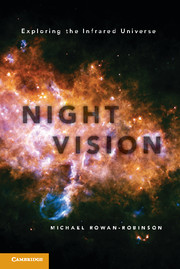Book contents
- Frontmatter
- Contents
- Preface
- 1 Introduction
- 2 William Herschel Opens Up the Invisible Universe
- 3 1800–1950
- 4 Dying Stars Shrouded in Dust and Stars Being Born
- 5 Birth of Submillimetre Astronomy
- 6 The Cosmic Microwave Background, Echo of the Big Bang
- 7 The Infrared Astronomical Satellite and the Opening Up of Extragalactic Infrared Astronomy
- 8 The Cosmic Background Explorer and the Ripples, the Wilkinson Microwave Anisotropy Probe and Dark Energy
- 9 Giant Ground-Based Near-Infrared and Submillimetre Telescopes
- 10 The Infrared Space Observatory and the Spitzer Space Telescope
- 11 Our Solar System’s Dusty Debris Disk and the Search for Exoplanets
- 12 The Future
- Epilogue
- Notes
- Credits for Illustrations
- Glossary
- Further Reading
- Bibliography
- Name Index
- Subject Index
Epilogue
Published online by Cambridge University Press: 05 March 2013
- Frontmatter
- Contents
- Preface
- 1 Introduction
- 2 William Herschel Opens Up the Invisible Universe
- 3 1800–1950
- 4 Dying Stars Shrouded in Dust and Stars Being Born
- 5 Birth of Submillimetre Astronomy
- 6 The Cosmic Microwave Background, Echo of the Big Bang
- 7 The Infrared Astronomical Satellite and the Opening Up of Extragalactic Infrared Astronomy
- 8 The Cosmic Background Explorer and the Ripples, the Wilkinson Microwave Anisotropy Probe and Dark Energy
- 9 Giant Ground-Based Near-Infrared and Submillimetre Telescopes
- 10 The Infrared Space Observatory and the Spitzer Space Telescope
- 11 Our Solar System’s Dusty Debris Disk and the Search for Exoplanets
- 12 The Future
- Epilogue
- Notes
- Credits for Illustrations
- Glossary
- Further Reading
- Bibliography
- Name Index
- Subject Index
Summary
I find the slow emergence of infrared astronomy a moving story. It began with the revolutionary discovery by the self-taught William Herschel in 1800 of invisible radiation from the Sun, the significance of which took so long to be fully appreciated. Reading his methodical and imaginative papers makes his genius clear. Piazzi Smyth made the next step, with detection of infrared radiation from the Moon in 1856. I found his book about his expedition to Tenerife captivating, one of the great works of scientific popularization from the Romantic era. There followed another 50 years of painstaking work trying to detect the brightest stars and planets in infrared light and the slow progress of stellar infrared astronomy in the first half of the twentieth century, culminating in the work of Harold Johnson and his group. In 1930, Robert Trumpler discovered the key ingredient for understanding the infrared sky: interstellar dust.
We then come to the titans of the modern era, Frank Low and Gerry Neugebauer, repeatedly being told they were wasting their time as they tried to push astronomy into the infrared. They and their colleagues from many different groups deserve immense credit for their pioneering work in the 1960s and 1970s. This led to the explosive development of infrared astronomy following the launch of the IRAS satellite in 1983. It was such an exciting time to see the clouds of interstellar dust directly shining at us in infrared light and to find some of the most distant galaxies known at that time, infrared monsters convulsed in huge bursts of star formation. Considering where infrared astronomy had been only a decade or so earlier, it was wonderful to be using IRAS as a cosmological probe, linking the infrared galaxy distribution to the cosmic microwave background radiation left over from the Big Bang itself. IRAS was followed by ever more sophisticated space missions: ISO, Spitzer, Akari and today Herschel. And then there have been the giant ground-based telescopes, working either in the optical and near infrared or at submillimetre wavelengths. To be searching in the 1990s for submillimetre sources one thousand times fainter than those we had been trying to observe only 20 years earlier seemed like magic.
- Type
- Chapter
- Information
- Night VisionExploring the Infrared Universe, pp. 185 - 186Publisher: Cambridge University PressPrint publication year: 2013



